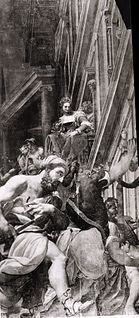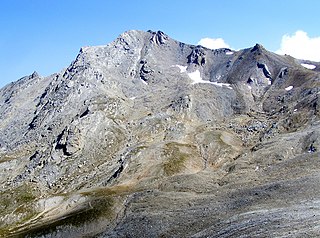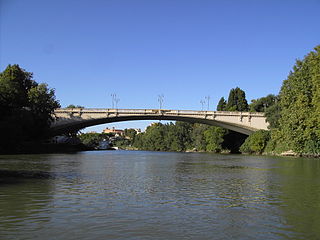
Giuseppe Francesco Ignazio Bertola born Roveda was an Italian military architect.

Giuseppe Francesco Ignazio Bertola born Roveda was an Italian military architect.
Born in 1676 in Tortona, Ignazio was the adopted son of the architect Antonio Bertola and followed in his footsteps as a military engineer. [1]

Tortona is a comune of Piemonte, in the Province of Alessandria, Italy. Tortona is sited on the right bank of the Scrivia between the plain of Marengo and the foothills of the Ligurian Apennines.
In 1720 he was commissioned to build or renovate the new defensive system of the Duchy of Savoy whose necessity had emerged after the Treaty of Utrecht.This work ended six years later, getting the approval of the military experts of the time. He made works of civil and military engineering in Alessandria and in Fenestrelle and built the so-called "road of the guns", a trail between the valleys Varaita and Maira.

From 1416 to 1860, the Duchy of Savoy was a state in Western Europe. It was created when Sigismund, King of the Romans, raised the County of Savoy into a duchy for Amadeus VIII. The duchy was a subject of the Holy Roman Empire with a vote in the Imperial Diet. From the 16th century, Savoy belonged to the Upper Rhenish Circle. Throughout its history, it was ruled by the House of Savoy and formed a part of the larger Savoyard state.

Alessandria is a city and comune in Piedmont, Italy, and the capital of the Province of Alessandria. The city is sited on the alluvial plain between the Tanaro and the Bormida rivers, about 90 kilometres southeast of Turin.
He held the office of Master of Fortresses and then First Engineer of Her Majesty.
He was the first director of the "School of Theory and Practice of Artillery of Piedmont", which was founded in 1736. In 1742 he was appointed count of Exilles by Charles Emmanuel III of Savoy. [1]

Piedmont is a region in northwest Italy, one of the 20 regions of the country. It borders the Liguria region to the south, the Lombardy and Emilia-Romagna regions to the east and the Aosta Valley region to the northwest; it also borders France to the west and Switzerland to the northeast. It has an area of 25,402 square kilometres (9,808 sq mi) and a population of 4 377 941 as of 30 November 2017. The capital of Piedmont is Turin.
Count (Male), or Countess (Female), is a historical title of nobility in certain European countries, varying in relative status, generally of middling rank in the hierarchy of nobility. The etymologically related English term, "county" denoted the land owned by a count. Equivalents of the rank of count exist or have existed in the nobility structures of some non-European countries, such as hakushaku during the Japanese Imperial era.

Exilles is a comune (municipality) in the Metropolitan City of Turin in the Italian region Piedmont, located about 60 kilometres (37 mi) west of Turin, on the border with France.

Victor Amadeus III was King of Sardinia from 1773 to his death. Although he was politically conservative, he carried out numerous administrative reforms until he declared war on Revolutionary France in 1792. He was the father of the last three mainline Kings of Sardinia.

Turin Cathedral is a Roman Catholic cathedral in Turin, northern Italy. Dedicated to Saint John the Baptist, it is the seat of the Archbishops of Turin.

The Palazzina di caccia of Stupinigi is one of the Residences of the Royal House of Savoy in northern Italy, part of the UNESCO World Heritage Sites list. Built as a royal hunting lodge in the early 18th century, it is located in Stupinigi, a suburb of the town of Nichelino, 10 km (6 mi) southwest of Turin

The Palatine Gate is a Roman Age city gate located in Turin, Italy. The gate provided access through the city walls of Julia Augusta Taurinorum from the North side and, as a result, it constituted the Porta Principalis Dextra of the old town.
Carlo Cognengo di Castellamonte (1560–1641) was an Italian architect, civil and military engineer, one of the main exponents of Piedmontese Baroque.

Giuseppe Meda was an Italian painter, architect and hydraulics engineer.
Giovanni Antinori was an Italian neoclassical architect. Employed by the papacy, he oversaw the re-erecting of three of Rome's obelisks - the Quirinale, the Sallustian and the Montecitorio.

The Fenestrelle Fortress, better known as the Fenestrelle Fort is a fortress overlooking Fenestrelle. It is the symbol of the Metropolitan City of Turin, Piedmont, northern Italy. It is the biggest alpine fortification in Europe, having a surface area of 1,300,000 m². The fortress, built by Savoy between 1728 and 1850 under the design of the architect Ignazio Bertola, guards the access to Turin via the Chisone valley and stands at altitudes between 1,100 and 1,800 m. The territory was acquired in 1709 by the Duchy of Savoy after the defeat of the French at Fort Mutin (Fenestrelle).

Punta Sommeiller or Pointe Sommeiller is a mountain of the Province of Turin, Italy and of Savoie, France. It lies in the Cottian Alps range. It has an elevation of 3,333 metres above sea level.

The Accademia Albertina di Belle Arti is an institution of higher education in Turin, Italy. Its precursor dated to the first half of the 17th century. In 1678 the academy was formally founded as the Academy of Painters, Sculptors and Architects by Marie Jeanne of Savoy. It was re-established under the name Albertina in 1883 by Charles Albert of Sardinia, who had architect Giuseppe Talucchi design and realize a new building on the former site of the convent of the Church of San Francesco da Paola. The academy witnessed the transition of artistic movements during the late 19th to early 20th century, from realism to eclecticism and the Liberty style, in the works of painters Antonio Fontanesi and Giacomo Grosso, and sculptors Vincenzo Vela and Odoardo Tabacchi. Turin became a leading centre of visual arts during the mid-20th century.

Giuseppe Manno was an Italian magistrate, politician and historian. He was elected president of the Senate of the Kingdom of Sardinia, and later of the Kingdom of Italy.
Francesco Aprile, was an Italian sculptor and stucco artist, born in what is now Switzerland, and mainly active in Turin, the Duchy of Savoy, but also Rome.

Ponte del Risorgimento is a bridge that links Piazzale delle Belle Arti to Piazza Monte Grappa in Rome (Italy), in the Flaminio and Della Vittoria quarters.

The Cittadella of Alessandria is a star fort and citadel in the city of Alessandria, Italy. It was built in the 18th century by the Kingdom of Sardinia, and today it is one of the best preserved fortifications of that era. It is one of the few fortifications in Europe still in their original environment, since there are no buildings blocking the views of the ramparts, or a road that surrounds the ditches.

The Santuario della Consolata or, in its full name, the Church of the Virgin of the Consolation is a prominent Marian sanctuary and minor basilica in central Turin, Piedmont, Italy. Colloquially, the sanctuary is known as La Consla. It is located on the intersection of Via Consolata and Via Carlo Ignazio Giulio.

The Exilles Fort is a fortified complex in the Susa Valley, Metropolitan City of Turin, Piedmont, northern Italy. Together with the nearby Fort of Fenestrelle and the Forte Albertino it was part of the defensive line between the House of Savoy lands and France: both these states held it in different phases depending on the outcome of the various wars. It is located on a spur commanding one of the narrowest sections of the Susa Valley, along the main road connecting Turin to France.
Giuseppe Albenga was an Italian civil engineer, professor of bridge construction, and historian of civil engineering.